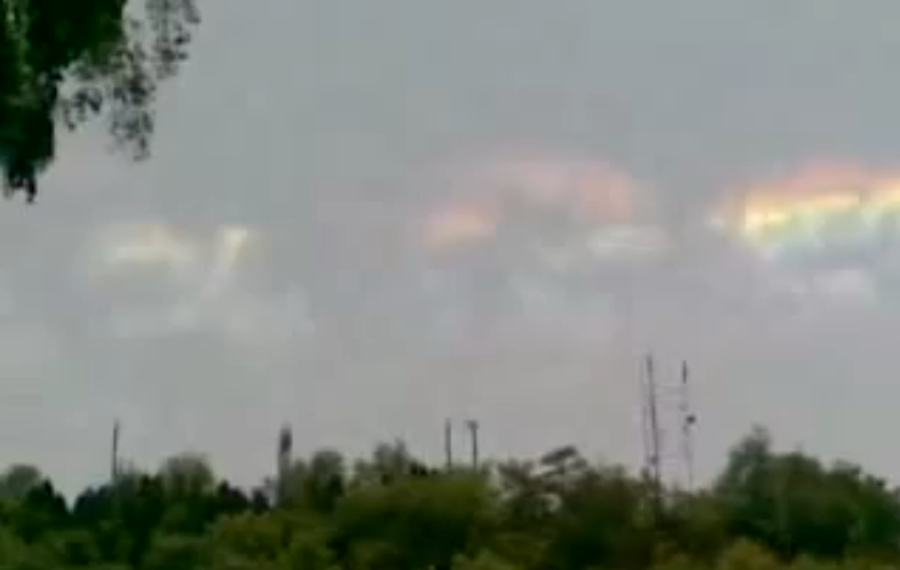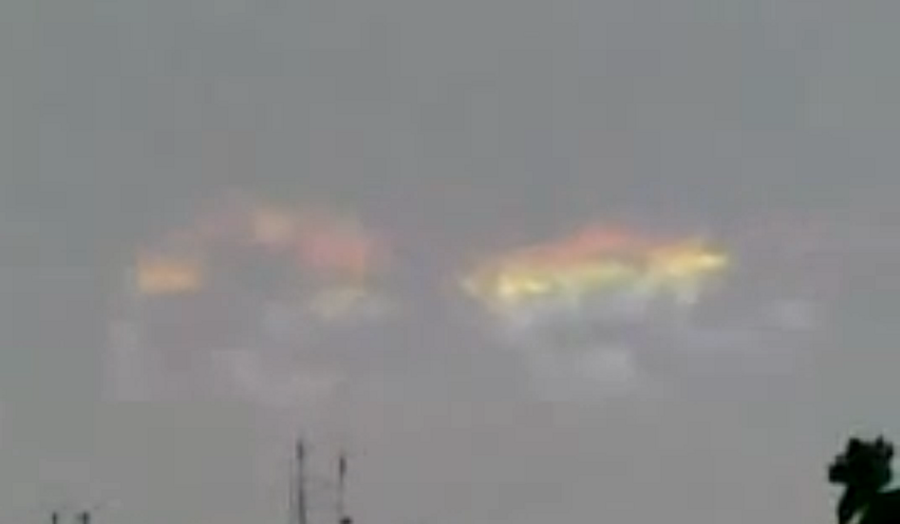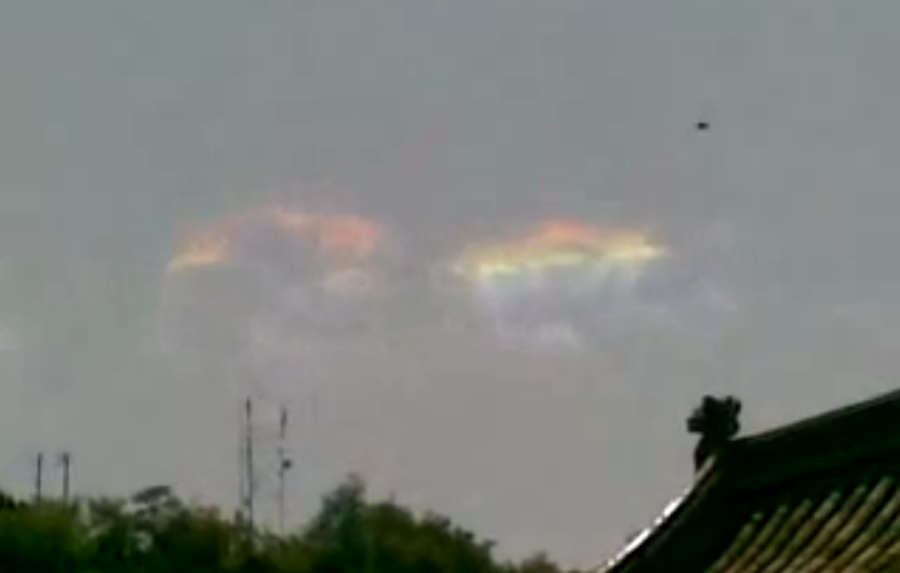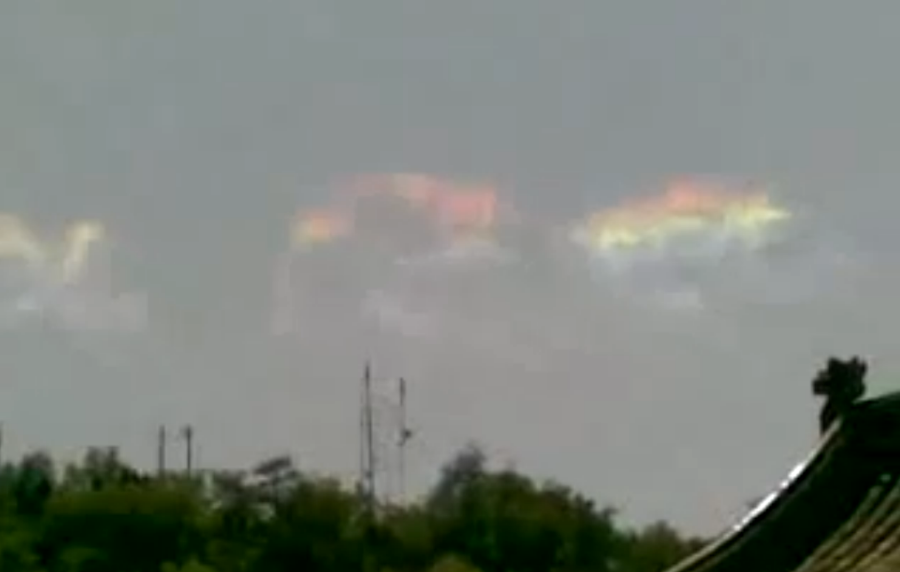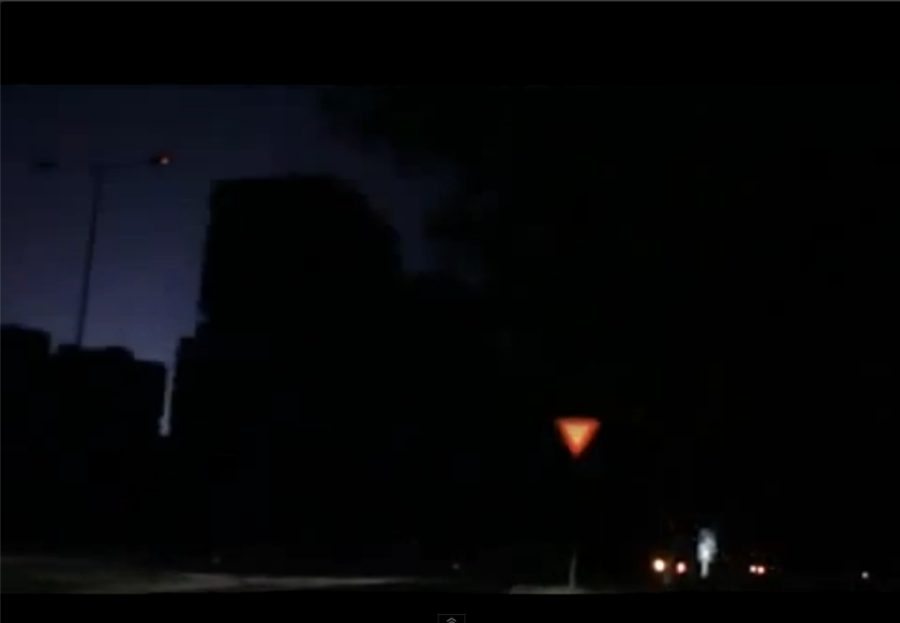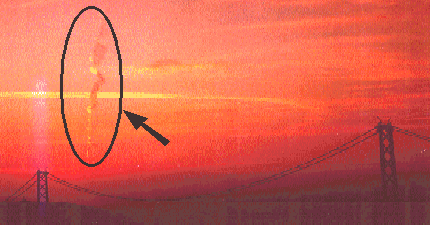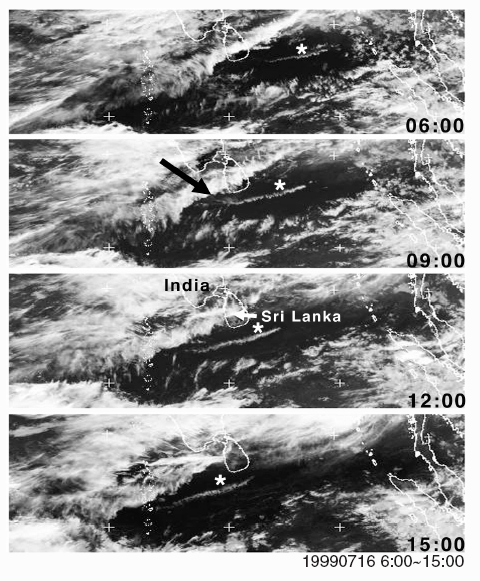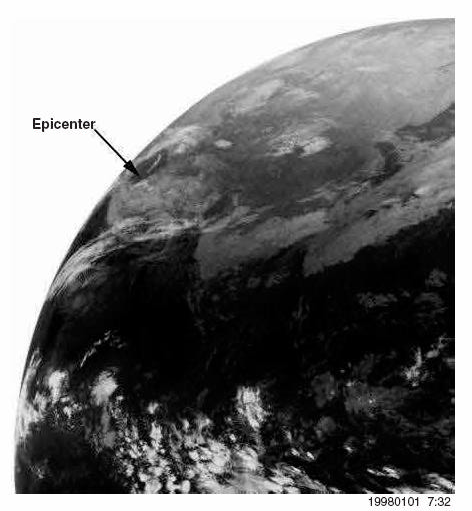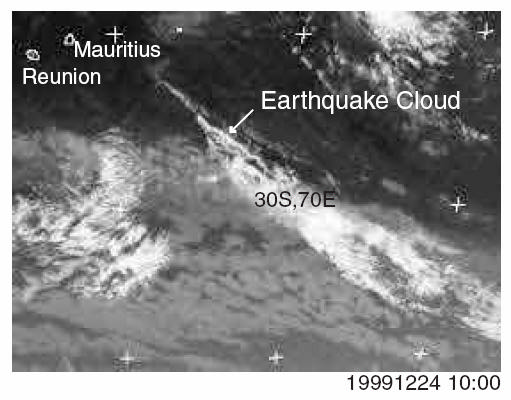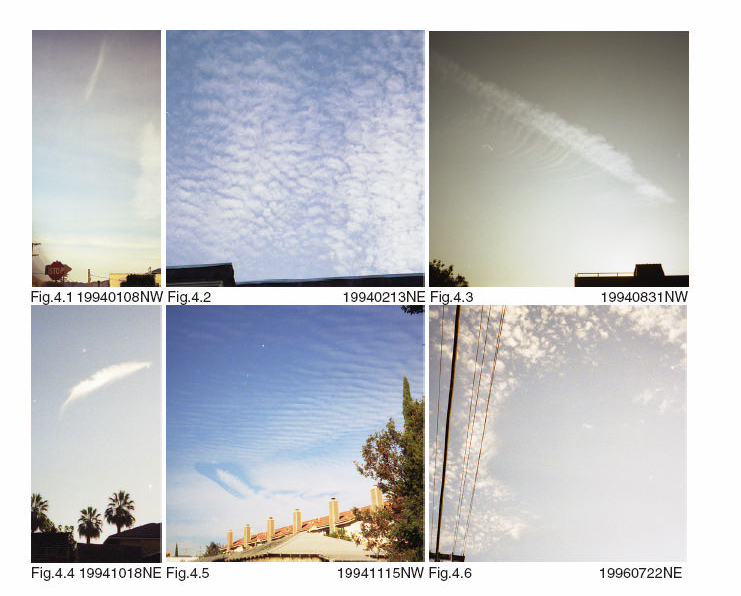Earthquake Light
|
The Enigmas on Earth |
|||||
|
30 Mins Before the 2008 Sichuan Earthquake in China . ..
Earthquake Light An earthquake light is an unusual
luminous aerial phenomenon that reportedly
appears in the sky at or near
areas of tectonic stress, seismic activity, or
volcanic eruptions. Once
commonly challenged, it was not until
photographs were taken during the
Matsushiro earthquake swarm in Nagano, Japan,
from 1965 through 1967, that
the seismology community acknowledged their
occurrence.
Appearance The lights are reported to appear while an earthquake is occurring, although there are reports of lights before or after earthquakes, such as reports concerning the 1975 Kalapana earthquake. They are reported to have shapes similar to those of the auroras, with a white to bluish hue, but occasionally they have been reported having a wider color spectrum. The luminosity is reported to be visible for several seconds, but has also been reported to last for tens of minutes. Accounts of viewable distance from the epicenter varies, in the 1930 Idu earthquake, lights were reported up to 70 miles from the epicenter. Earthquake lights were reportedly spotted in Tianshui, Gansu, approximately 400 km north-northeast of the earthquakes epicenter. The phenomenon was also widely observed and caught on film during the 2007 Peru, 2008 Sichuan, 2009 L'Aquila, and 2010 Chile earthquakes.[6] The phenomenon was also reported around the Aimuri Earthquake in New Zealand, that occurred 1 September 1888. The lights were visible in the morning of 1 September in Reefton, and again on the 8th of September.
Theories Earthquake lights are caused by an unknown mechanism. There are numerous theories as to how and why they occur. One explanation involves intense electric fields created piezoelectrically by tectonic movements of rocks containing quartz.There is also debate in the scientific community regarding radon as a possible precursor to some earthquakes, so another theory is that glowing clouds might be light emission produced by ionization or plasma-chemical reactions
Papers:
|
|||||
| Earthquake
Booms, Seneca Guns, and Other Sounds
Introduction & Basics Earthquake "booms" have been reported for a long time, and they tend to occur more in the Northeastern US and along the East Coast. Of course, most "booms" that people hear or experience are actually some type of cultural noise, such as some type of explosion, a large vehicle going by, or sometimes a sonic boom, but there have been many reports of "booms" that cannot be explained by man-made sources. No one knows for sure, but scientists speculate that these "booms" are probably small shallow earthquakes that are too small to be recorded, but large enough to be felt by people nearby. As it turns out....there are many factors that contribute to the "sound' that an earthquake makes. To begin to understand these factors we have to understand the different types of waves, the speed they travel through the earth, and the speed that sound travels through the air. See this easy to understand, detailed explanation. Perhaps the best way to understand earthquake sounds are from an actual experiment that took place back in the 80's in California by David Hill. Dr. Hill's team recorded sounds that came out of the earth (from nearby small earthquakes between magnitude 2.0 and 3.0) and simultaneously measured the arrival of the P wave on a seismograph. Researchers also reported hearing a sound before the S waves were recorded; this turned out to be the arrival of the P wave. See this Alaska Science Forum article entitled "Earthquake Waves Outrace Sound" for a description of that experiment. Observations
of Earthquake Sounds
The most recent documented earthquake sounds were from a swarm of small earthquakes that unnerved the city of Spokane, WA in 2001. Many of the Spokane quakes were definitely accompanied by "booming sounds". The quakes in Spokane were shallow, sometimes only a mile or two deep. This probably contributed to all the noise they made. Higher-frequency vibrations make the booming sound, and when quakes are deeper, those vibrations are gone by the time they reach the surface. Sometimes the quakes boom even when no vibration is felt. See the
Seattle Post-Intelligencer
Reporter article "A mysterious swarm of noisy
earthquake unnerves Spokane".
There are accounts of "artillery"-like sounds that were said to have occurred before or during the New Madrid earthquakes of 1811-1812. SOURCE: USGS Earthquake Booms, Seneca Guns, and Other Sounds Earthquake Lights Magnitude 8.0 - Near the Coast of Central Peru Possible earthquake lights observed at Lima SOURCE: USGS 1930 07 23 Irpinia, Italy 41.05N 15.37E 1,404 6.5 Most of the damage was in the Ariano Irpino-Melfi area of Avellino, Potenza and Foggia Provinces. Damage occurred as far away as Napoli (Naples). The quake was felt from the Po Valley to Catanzaro and Lecce Provinces. Earthquake lights were reported in the epicentral area. SOURCE: USGS 1962 09 01 Bu'in Zahra, Qazvin, Iran 35.6N 49.9E 12,225 7.1 Ninety-one villages destroyed and 233 damaged - over 21,000 houses destroyed, nearly all built of poor-quality materials. Slight damage at Tehran. Felt as far away as Tabriz, Esfahan and Yazd. Based on damage to old structures, this was probably the largest earthquake in this immediate area since at least 1630. Surface faulting with small offsets occurred in a 100-km (63-mi) east-west zone of the Ipak Fault. Some landslides and sandblows occurred. Earthquake lights (a red to orange glow) from the Rudak area were observed prior to the quake by various people. SOURCE: USGS Feb 1991 Southern Xinjiang, China 25 14:30:27.6 40.386 78.959 21 D 5.5 6.1 1.0 289 Southern Xinjiang, China. Mo=1.3*10**18 Nm (HRV). Three people were injured and at least 120 houses collapsed an 8,441 houses damaged in the Kalpin area. Ground cracks and earthquake lights were reported in the epicentral area. Felt at Akqi, Aksu, Bachu and Wasi. SOURCE: USGS Nov 15, 2004 West Coast of Colombia NOV 15 09 06 56.5 4.695 N 77.508 W 15 G 7.2 0.9 708 near the West Coast of Colombia. MW 7.2 (GS), 7.2 (HRV). mb 6.6 (GS). MS 7.1 (GS). ME 7.4 (GS). Mo 7.6*10**19 Nm (HRV), 6.6*10**19 Nm (GS), 4.6*10**19 Nm (PPT). Es 2.8*10**15 Nm (GS). Two people seriously injured, four others slightly injured, at least 154 buildings destroyed and 290 damaged in Bajo Baudo. Seven people injured and at least 67 houses destroyed or damaged at Buenaventura. One person injured and some buildings damaged at Cerrito. Buildings damaged at El Cairo, Jamundi and Restrepo. Some damage and power and telephone service interrupted at Cali. Power interrupted at Bogota. Felt at Armenia, Quibdo and in much of western and central Colombia. Felt lightly by people in tall buildings at Quito, Ecuador. Earthquake lights observed in the area. SOURCE: USGS November 29, 1975 Kalapana Earthquake During and immediately after the main shock, 'earthquake lights' of white to bluish flashes or glows lasting several seconds were reported by a number of observers. Earthquake lights are associated with major earthquakes and have been observed in Japan and California. The lights are believed to be results of earthquake-induced distortions of the atmosphere. SOURCE: USGS Glowing lights around an earthquake's epicentre February 27 2008 - Market Rasen, Lincolnshire, UK One witness described how a grapefruit-sized glowing sphere appeared in her bedroom and then went out like a light. “This thing seemed to be coming across the room straight at me. I was very frightened,” she told the Louth Leader. Another person described flashes like car headlights at her window, and others spoke of lightning flashes after the quake. However, there was no lightning activity at the time of the quake. Tangshan, China July 1976 People in Tangshan were awakened one night in July 1976 by bright flashes in the sky. Two days later an earthquake registering 7.8 on the Richter scale killed 240,000 people and destroyed the city. Matsushiro, Japan 1965-67 A Japanese scientist took photographs of balls of light and red streaks in the sky during a swarm of earthquakes in Matsushiro between 1965 and 1967. One explanation for his phenomenon is that the electrical properties of rocks may change under severe stress before or during a quake. This may generate changes in the electrical behaviour of the atmosphere, ionising the air and producing glowing lights. Source Glowing lights around an earthquake's epicentre - February 27 2008 - The Sunday Times |
|||||
|
..
..
|
|||||
|
.
This earthquake cloud was taken before the Kobe earthquake in Japan. |
|||||
| Bam Earthquake
Prediction &
Space Technology
Introduction The principal application of space technology to earthquake prediction has traditionally been measurements of ground motion. While this approach has contributed significantly to geophysical studies, it has not yet yielded an earthquake prediction method. An alternative approach that has recently shown great promise is satellite imaging of strange non- meteorological cloud formations and their correlation with earthquakes. Shou used such a cloud (see Fig. 1) to predict the Bam earthquake of Dec. 26, 2003 to the public. Coarse and fine predictions were made public on the internet (@1) at 17:58 UTC, Dec. 25, 2003. The fine prediction stated that there would be an earthquake of magnitude more than or equal to 5.5 within 60 days along a fault described in Fig. 1, while the coarse prediction allowed magnitude 5 and above, within 98 days. The Bam earthquake occurred precisely on the predicted fault, and its magnitude was within the predicted magnitude windows. The first known record of this kind of earthquake precursor is the Chronicle of Lon-De County, China, 381 years ago (recompiled in 1935): "It was sunny and warm; the sky was blue and clear. Suddenly, there appeared threads of black clouds spanning the sky like a long snake. The clouds stayed for a long time, so there would be an earthquake" (1). The predicted earthquake was the magnitude 7.0 Guyuan (36.5 N, 106.3 E), Ningxia province earthquake on Oct. 25, 1622. It was the only big one in Western China (< 110 E) within 148 years from Jul. 26, 1561 to Oct. 13, 1709 (2), so this prediction is remarkable. This method was recently revived in Japan and China. On the morning of Mar. 6, 1978 Kagida, the former mayor of Nara city, Japan, predicted the 7.8 Kantow earthquake on Mar. 7 by the clouds (1). He also proposed that the epicenter of an earthquake would be located in the mid-perpendicular plane of the clouds, which later proved to be incorrect. Following this successful prediction, there was a brief period of activity in the scientific communities in China and Japan. Three kinds of earthquake clouds: rope-shaped, ribshaped (we denote it wave-shaped), and radiation-shaped, were announced. Unfortunately, the connection between clouds and earthquakes faded from view after 1985. On the other hand, Shou made his first earthquake prediction in Hangzhou (30.25N, 120.17E), China by a long line-shaped cloud with a tail pointing in the northwest direction on Jun. 20, 1990. 18 hours later, a magnitude 7.7 earthquake struck Iran, and killed or injured 370,000 people. Because the earthquake was the only one bigger than 7 to the northwest of Hangzhou for 333 days from May 31, 1990 to Apr. 28, 1991, He believed that there must be a strong relationship between the cloud and the earthquake. As long as the epicenter was not located by Kagida's law, but on where the cloud's tail pointed toward, He believed that the method of earthquake clouds should not have been abandoned. Over the last 10 years, with the aid of satellite weather images available on the internet (@ 2-10) Shou has observed similar correlations in sufficient numbers to enable the development of a successful earthquake prediction method. He has used this method to generate 50 independent predictions certified by the United States Geological Survey (USGS), of which 36 were correct. We will describe a model to explain the correlations, a statistical analysis of the set of predictions, and prospects for improving the both precision and reliability of the predictions.
Bam Earthquake Cloud This image of IndoEx satellite shows an earthquake cloud emerging from fault AB on Dec. 21, 2003, marked by a white arrow, by which Shou predicted an M5.5 or bigger earthquake in Fault AB within 60 days on Dec. 25, 2003 to the public. On Dec. 26, an earthquake of 6.8 Ms happened in Bam (28.99N, 58.29E), Iran (marked by *), exactly where the cloud had emerged. Earthquake Cloud Model Shou first proposed a model for the formation of earthquake clouds (2). When a huge rock is stressed by external forces, its weak parts break first and small earthquakes occur. For example, the Southern California earthquake data (@11) show that small shocks happened before and around all large hypocenters there (Table 1). The fact that a large earthquake produces a large gap suggests that small shocks generate small crevices, which reduce the cohesion of the rock. Next, underground water percolates into the crevices. Its expansion, contraction, and chemistry further reduce the cohesion. Friction heats the water and eventually generates vapor at high temperature and pressure. The vapor erupts from an impending hypocenter to the surface by the crevices, and rises up. It forms a cloud while encountering cold air. This kind of cloud, whose vapor is from an impending hypocenter, is denoted an earthquake cloud. Anecdotal evidence for high temperature and high pressure vapor is plentiful (2-16), as is evidence for the clouds themselves. Fig. 2 shows damage to the ceiling of a structurally intact building due to the eruption of steam from underneath it during the 7.8 Tangshan Earthquake on Jul. 28, 1976 (17). |
|||||
The 7.8 Turkey earthquake cloud These infrared images were from the IndoEx satellite from 6:00 to 15:00 on Jul.16,1999. At 6:00, a linear cloud appeared in a large clear sky near Sri Lanka. The cloud lengthened as it moved eastward, and then disappeared after 15:00. The length of the cloud, 800 km, suggested an earthquake of magnitude over 7. The tail (see 9:00) pointed to the northwest, and indicated that the epicenter would be in a region from Iran to Italy. However, the satellite images did not show the exact epicenter, and Shou did not know it until Aug. 17, 1999 when the 7.8 Turkey earthquake happened at 40.74N, 29.86E. |
|||||
The M6.1 Afghanistan earthquake cloud This image was taken from a composite of the GMS satellite, provided by University College London. At about 7:32 Jan.1, 1998, a hole with a line-shaped cloud inside appeared in a large weather cloud. The line-shaped cloud disappeared at about 16:25. Shou predicted an earthquake of magnitude larger than or equal to 6 in Afghanistan and its neighbors, with a coarse window of 25~41N and 53~105E from Jan. 5 to Feb. 18, and a fine window of 30~37N and 58~95E, from Jan.5 to Feb.4, 1998 to the USGS. The 6.1 Afghanistan earthquake at Rustaq (36.83~ 37.31N, 69.5~70.11E) marked by the tip of the arrow, on Feb. 4 proved the both coarse and fine predictions correct. |
|||||
The Union of Six Earthquake Clouds This Infrared image of IndoEx satellite revealed a linear cloud, marked by arrow near 30S, 70E over the Indian Ocean at 10:00, Dec. 24, 1999. By this cloud, 550 km in length, Shou predicted an M7 earthquake over 20S in the Indian Ocean from Dec. 27, 1999 to Feb. 10, 2000, with a fine area window of 25~28S and 60~80E. However, not one M7, but 6 M5 earthquakes occurred in this window on Feb. 9~10, 2000 (Prediction No. 38 in Table 5).. |
|||||
Various Shapes of Earthquake Clouds This set shows six different shapes of earthquake clouds, photographed by Shou from Pasadena (34.14 N, 118.14 W), California. Under each photo are the date and the direction Shou took the photo. The line-shaped cloud in Fig. 4.1 appeared suddenly like a launching rocket northwest of Pasadena, and predicted the 6.7 Northridge earthquake at 34.21N, 118.53W, in the same direction, on Jan. 17, 1994. The waveshaped cloud in Fig. 4.2 was from northwest to northeast, and predicted the 5.3 Northridge earthquake on Mar. 20, 1994. The line-shaped cloud in Fig. 4.3 appeared suddenly from northwest, and predicted the 7.1 Off Coast of Northern California earthquake at 40.40N, 125.68W on Sep. 1, 1994. The feather-shaped cloud in Fig. 4.4 from northwest to northeast predicted the 6.3 Off Coast of Oregon earthquake at 43.51N, 127.42W on Oct. 27, 1994. The lantern-shaped cloud in Fig.4.5 from northwest predicted the 6.8 Off Coast of Northern California earthquake at 40.55N, 125.53W on Feb. 19, 1995. The radiation-pattern-shaped cloud in Fig. 4.6 rising up from northeast predicted the 4.4 Joshua Tree earthquake at 34.59N, 116.28W, in the same direction, on Aug. 14, 1996. All these clouds were not described by meteorology, but the both wave-shaped and radiation-shaped clouds were denoted earthquake clouds by Chinese and Japanese scientists in 1979. |
|||||
| FAIR USE NOTICE: This page contains copyrighted material the use of which has not been specifically authorized by the copyright owner. Pegasus Research Consortium distributes this material without profit to those who have expressed a prior interest in receiving the included information for research and educational purposes. We believe this constitutes a fair use of any such copyrighted material as provided for in 17 U.S.C § 107. If you wish to use copyrighted material from this site for purposes of your own that go beyond fair use, you must obtain permission from the copyright owner. | |||||
|
|
